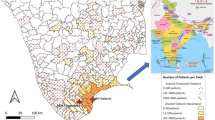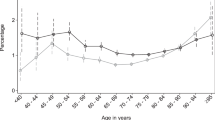Abstract
Purpose
To report trends in cataract surgery indications, visual acuity outcomes, complication rates and reoperation rates at ten Aravind Eye Hospitals in Tamil Nadu, India.
Methods
In this retrospective database study we analyzed seven years of data of cataract surgeries at Aravind during January 1, 2012 to December 31, 2018. Our main outcome measures were preoperative and 1-month postoperative uncorrected visual acuity (UCVA) and best-corrected visual acuity (BCVA); and rates of intraoperative complications and reoperations. We performed Cochran–Armitage trend tests.
Results
In 1.86 million eyes that underwent cataract surgery, the percentage of eyes undergoing phacoemulsification (PE) showed an increasing trend (p < 0.0001), from 26.8% in 2012 to 33.5% in 2018. The percentage of eyes undergoing manual small incision cataract surgery (SICS) showed a decreasing trend (p < 0.0001), from 70.0% in 2012 to 65.1% in 2018. For SICS, the percentages of eyes with good postoperative UCVA and BCVA showed increasing trends (p < 0.0001 for each), and the percentages of eyes with poor postoperative UCVA and BCVA showed decreasing trends (p < 0.0001 for each). Results for PE surgeries were mixed. For both PE and SICS rates of intraoperative complications showed a declining trend (p < 0.0001 for each) and a slight increasing trend for reoperations (PE p < 0.02; SICS p < 0.0001).
Conclusions
During this seven-year period there were noticeable trends in cataract surgeries performed at Aravind in terms of the mix of surgical procedures, preoperative vision, and cataract surgical outcomes.
Similar content being viewed by others
Log in or create a free account to read this content
Gain free access to this article, as well as selected content from this journal and more on nature.com
or
References
Lindfield R, Vishwanath K, Ngounou F, Khanna RC. The challenges in improving outcome of cataract surgery in low and middle income countries. Indian J Ophthalmol. 2012;60:464–9.
Lewallen S, Thulasiraj RD. Eliminating cataract blindness - how do we apply lessons from Asia to sub-Saharan Africa? Glob Public Health. 2010;5:639–48.
World Health Organization. Informal consultation on analysis of blindness prevention outcomes. 1998. http://apps.who.int/iris/handle/10665/67843. Accessed 5 June, 2017.
Le H-G, Ehrlich JR, Venkatesh R, Srinivasan A, Kolli A, Haripriya A, et al. A sustainable model for delivering high-quality, efficient cataract surgery In Southern India. Health Aff Proj Hope. 2016;35:1783–90.
Anon. National Programme for Control of Blindness, Ministry of Health & Family Welfare, Government of India. http://npcb.nic.in/index1.asp?linkid=93&langid=1. Accessed 11 March, 2019.
Gupta S, Ravindran RD, Subburaman G-BB, Vardhan A, Ravilla T. Evidence on importance of follow-up visits after cataract surgery. Ophthalmology. 2018;26:910–2.
Limburg H, Foster A, Gilbert C, Johnson GJ, Kyndt M, Myatt M. Routine monitoring of visual outcome of cataract surgery. Part 2: Results from eight study centres. Br J Ophthalmol. 2005;89:50–52.
OCTET Team. Use of a grading system in the evaluation of complications in a randomised controlled trial on cataract surgery. Oxford Cataract Treatment and Evaluation Team (OCTET). Br J Ophthalmol. 1986;70:411–4.
Agresti A. Categorical data analysis. 2nd ed. New York: Wiley-Interscience; 2002. https://doi.org/10.1002/0471249688.
Rengaraj V, Ma SS, Chang DF. Manual small-incision cataract surgery. In: Henderson BA, ed. Manual small incision cataract surgery. Cham: Springer International Publishing; 2016. p. 1–15. http://link.springer.com/10.1007/978-3-319-24666-6_1. Accessed 20 Dec, 2018.
Gogate P, Deshpande M, Nirmalan PK. Why do phacoemulsification? Manual small-incision cataract surgery is almost as effective, but less expensive. Ophthalmology. 2007;114:965–8.
Vashist P, Talwar B, Gogoi M, Maraini G, Camparini M, Ravindran RD, et al. Prevalence of cataract in an older population in India. Ophthalmology. 2011;118:e2.
John N, Rachel J, Praveen V, Murthy GVS. Rapid Assessment of Avoidable Blindness in India. PLoS ONE 2008;3. Available at: https://www.ncbi.nlm.nih.gov/pmc/articles/PMC2478719/. Accessed April 11, 2019.
Ravilla TD, Gupta S, Ravindran RD, Vashist P, Krishnan T, Maraini G, et al. Use of cooking fuels and cataract in a population-based study: the India eye disease study. Environ Health Perspect. 2016;124:1857–62.
Lundström M, Goh P-P, Henry Y, Salowi MA, Barry P, Manning S, et al. The changing pattern of cataract surgery indications: a 5-year study of 2 cataract surgery databases. Ophthalmology. 2015;122:31–38.
Eye Diseases Prevalence Research Group. Prevalence of cataract and pseudophakia/aphakia among adults in theUnited States. Arch Ophthalmol. 2004;122:487–94.
Misra V, Vashist P, Malhotra S, Gupta SK. Models for primary eye care services in India. Indian J Community Med Publ Indian Assoc Prev Soc Med. 2015;40:79–84.
Keenan T, Rosen P, Yeates D, Goldacre M. Time trends and geographical variation in cataract surgery rates in England: study of surgical workload. Br J Ophthalmol. 2007;91:901–4.
Taylor HR, Vu HTV, Keeffe JE. Visual acuity thresholds for cataract surgery and the changing Australian population. Arch Ophthalmol Chic Ill 1960 2006;124:1750–3.
Behndig A, Montan P, Stenevi U, Kugelberg M, Lundstrom M. One million cataract surgeries: Swedish National Cataract Register 1992-2009. J Cataract Refract Surg. 2011;37:1539–45.
Gollogly HE, Hodge DO, St Sauver JL, Erie JC. Increasing incidence of cataract surgery: population-based study. J Cataract Refract Surg. 2013;39:1383–9.
Erie JC. Rising cataract surgery rates: demand and supply. Ophthalmology. 2014;121:2–4.
Shah SP, Gilbert CE, Razavi H, Turner EL, Lindfield RJ. Preoperative visual acuity among cataract surgery patients and countries’ state of development: a global study. World Health Organ Bull World Health Organ Geneva. 2011;89:749–56.
Gupta S, Ravindran RD, Subburaman G-BB, Vardhan A, Ravilla T. Predictors of patient compliance with follow-up visits after cataract surgery. J Cataract Refract Surg. 2019;45:1105–12.
Haripriya A, Chang DF, Reena M, Shekhar M. Complication rates of phacoemulsification and manual small-incision cataract surgery at Aravind Eye Hospital. J Cataract Refract Surg. 2012;38:1360–9.
Author information
Authors and Affiliations
Corresponding author
Ethics declarations
Conflict of interest
The authors declare that they have no conflict of interest.
Additional information
Publisher’s note Springer Nature remains neutral with regard to jurisdictional claims in published maps and institutional affiliations.
Supplementary information
Rights and permissions
About this article
Cite this article
Ravindran, R.D., Gupta, S., Haripriya, A. et al. Seven-year trends in cataract surgery indications and quality of outcomes at Aravind Eye Hospitals, India. Eye 35, 1895–1903 (2021). https://doi.org/10.1038/s41433-020-0954-5
Received:
Revised:
Accepted:
Published:
Issue date:
DOI: https://doi.org/10.1038/s41433-020-0954-5



